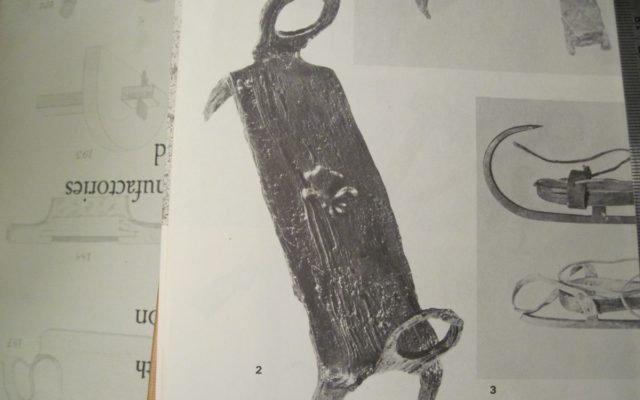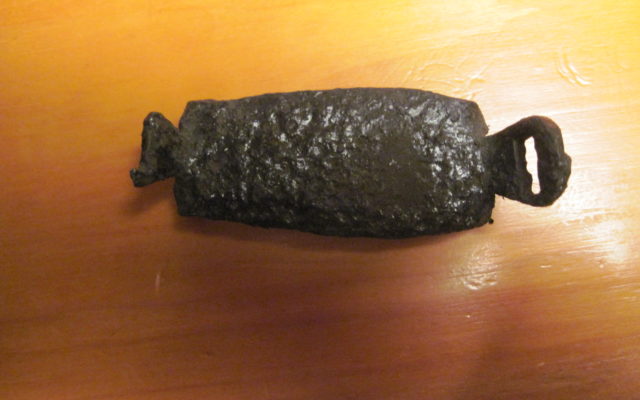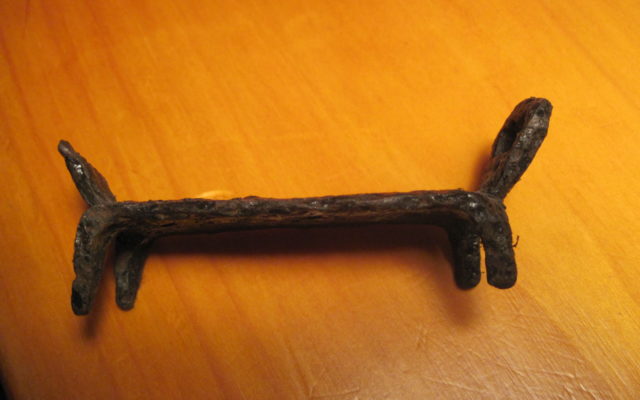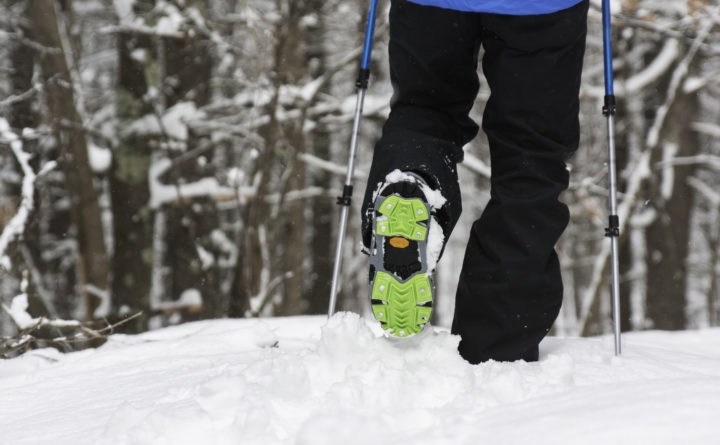
In Maine, when your driveway inevitably turns into a perilous chute of ice, you haul out the rock salt, scatter some gravel and — if you’re serious about not falling on your behind — strap on some ice cleats.
Now available in a variety of designs, ice cleats have become increasingly popular in recent years as outdoor brands have released models that serve everyone from city slicker to mountaineer. And while this may seem like a new trend, it’s actually a resurgence of a piece of outdoor gear that has a long and fascinating history, especially in places like Maine, where ice storms are frequent, and ice sports, such as ice sailing and ice fishing, are celebrated hobbies.
While it’s impossible to pinpoint exactly who created the very first ice cleats, some of the oldest ice cleat artifacts date back to the Viking Age.
“Two were found in Birka [a Viking city in Sweden] in a woman’s grave,” Antje Wendt, curator at The Swedish History Museum in Stockholm, said in an email. “They are around 1,100 years old … These were obviously used by this woman, but there are other examples for horseshoes as well.”
These iron spikes — one per foot — were strapped to the bottom of the Vikings’ shoes to prevent them from slipping on ice, according to the museum.
And it makes sense. People living thousands of years ago didn’t want to fall down any more than people do today.
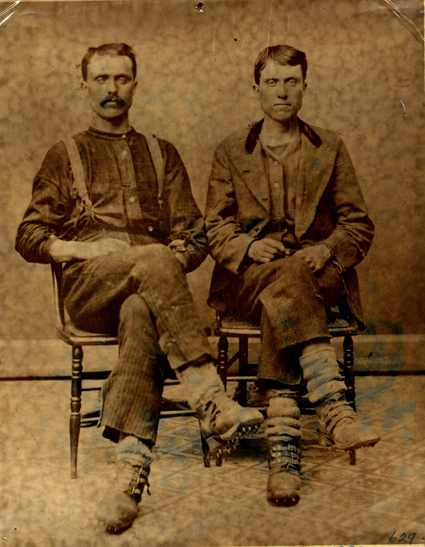
Two loggers from the Patten area pose with their log driving clothes and in the late 1800s or early 1900s. Their gear includes caulk boots, which had metal spikes screwed into their soles that would give them better traction while walking over floating logs during log drives. (Courtesy of the Patten Lumbermen’s Museum)
Other early ice cleat users include 16th century shepherds in the Alps, who would attach horseshoe nails to wooden or metal frames to help them gain traction on the icy slopes, according to “Ice World: Techniques and Experiences of Modern Ice Climbing” by Jeff Lowe.
In Maine and throughout the Northeast, there is evidence that ice cleats were used by early settlers and adopted by the native tribes they established trade with.
Kent Hamilton, a private researcher and historian from Corinth, owns what he believes to be the oldest ice cleats found in the country, and they were unearthed right in Castine.
“This is the oldest ice creeper that I know of [in North America],” Hamilton said. “And I’ve been looking at this stuff really hard for about 30 years.”
Based on the objects found with the ice cleats and the cleats’ four-spike design, Hamilton believes they predate 1674, when the nearby Fort Pentagoet, a fortified trading post established by French fur traders, was destroyed by the Dutch. Some of the items found buried with the ice cleats match items that were found in archeological digs of the fort.
The metal spikes on the artifact are short, which suggests to Hamilton that the cleats were worn with moccasins, the typical winter footwear of that place and time. The other, less practical option would have been buckle shoes, which have a heel that would require longer spikes for traction, he said.
Hamilton has compared the four-spike design to similar cleats created for the French army for the French and Indian War (1754-63). Similar cleats were also created by the British, he said. And they have been excavated from sites of old Native American villages throughout the Northeast.
The simple design — a metal bar with four spikes strapped around a shoe — went virtually unchanged for many years.
“It perfectly segued into the logging industry [in Maine],” Hamilton said. “They’d put these very similar cleats on your feet so you could jump from log to log. They just modified them and souped them up.”
In the 1800s and well into the 1900s, Maine logging companies moved timber by floating the logs down rivers in what’s known as “log drives.” Along the way, these logs would often get stuck — or “jam” — forcing loggers to walk and run over the floating logs to manually free the logs with tools called peaveys. This dangerous job required special footwear known as caulk boots, which were covered with metal spikes that helped them gain purchase on the bobbing and rolling timber.
“The caulks or spikes would screw into the bottom of the boot,” said Rhonda Brophy, curator of the Patten Lumbermen’s Museum. “We have probably four or five pair of them at the museum.”
Loggers may have also worn these boots in especially icy conditions, since they worked all winter harvesting timber to ship down river with the spring thaw. However, these boots were primarily used for walking on logs, Brophy said, not ice.

Images of old ice cleats, including one constructed in England in the 1700s that was marked with a broad arrow, a symbol that was used in England in the mid-1700s to mark government property, such as ice cleats used by soldiers. (Courtesy of Ken Hamilton)
“There was actually an ordinance the government put into effect back in the 1900s that prohibited [loggers] from wearing them on buses and in restaurants because they marked up the floors so bad,” she said.
Unlike caulk boots, ice cleats have always been an accessory that can be easily removed from footwear.
“I have some that my great-grandmother used,” said Sherry Davis, program coordinator for the Maine Forest and Logging Museum. “The strapped on with a piece of leather.”
With six spikes and sliding metal bars, the ice cleats owned by her great-grandmother could be adjusted to different boot sizes. Compared to the old four-spike design, the model is much more sophisticated, creeping toward the look of the modern ice cleat, which typically features many spikes and is highly adjustable.
The invention of the modern ice cleats for mountaineering — also known as crampons — is often attributed to two men, British mountaineer Oscar Eckenstein and Italian blacksmith Laurent Grivel, who worked together to create and market a 12-pointed crampon in 1932 that revolutionized mountain climbing.
Today, Grivel, a company started in 1818 by Laurent Grivel’s ancestors, continues to create and sell climbing equipment and crampons — and though the manufacturing process and materials have improved over the years, the overall design of the crampons has gone largely unchanged.
In addition, a number of outdoor brands have realized the value of ice cleats and developed their own designs — including a highly successful company, STABIL, which a Maine couple started in their basement in 1991.
Using a design they purchased from a man in New Brunswick, Anne and David Gould developed the STABILicer, a versatile ice cleat made of tiny metal spikes embedded in plastic that stretches around and clings to the bottom of boot. Over the years, this design has been altered, and the company has developed additional ice cleat models for walking, hiking, running and working.
In May of 2018, the company was purchased by Implus LLC, an international company based in North Carolina that deals in fitness accessories and devices. However, certain models of STABILicers continue to be manufactured in Kennebunk and Lewiston with offices in Brunswick. And these Maine-made ice cleats continue to be sold at L.L. Bean and other outfitters around the state.
“But there’s a lot of thought that goes into how the product is designed and attached to the shoe,” said John Milburn, formerly president of STABIL and now vice president of key accounts for Implus LLC. “But metal cleats continue to be the best application for true traction on ice and snow.”
- An image of an ice cleat created by the French in the 1700s. (Courtesy of Ken Hamilton)
- Ice cleats found in Castine that is likely predate 1674, when the nearby Fort Pentagoet, a fortified trading post established by French fur traders, was destroyed by the Dutch. Some of the items found buried with the ice cleats match items that were found in archeological digs of the fort. (Courtesy of Ken Hamilton)
- Ice cleats found in Castine that is likely predate 1674, when the nearby Fort Pentagoet, a fortified trading post established by French fur traders, was destroyed by the Dutch. Some of the items found buried with the ice cleats match items that were found in archeological digs of the fort. (Courtesy of Ken Hamilton)

